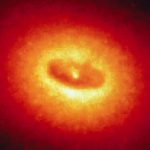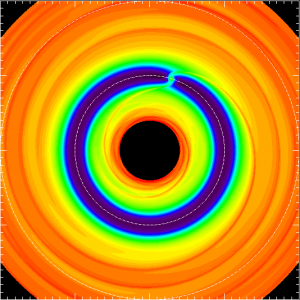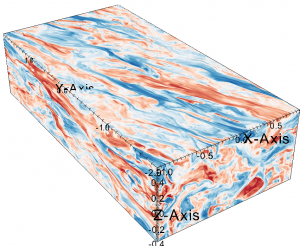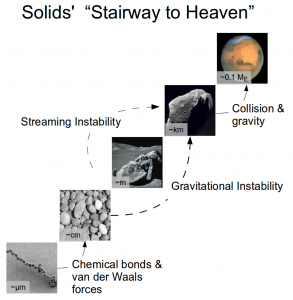Research
My research centers on astrophysical fluid dynamics, MHD and radiative process in the context of accretion flows and other objects. A common thread in my research is to utilize physical theories and numerical experiments to understand how those astronomical objects form, sustain and evolve.
A few of my research interests are:
 Active Galactic Nuclei (AGNs) are compact objects residing at the heart of galaxies. Powered by accretion process of supermassive black holes, they are so luminous that they even outshines their host galaxies. The unified model of AGNs requires geometrically thick dusty tori to explain the various AGN properties as an effect of orientation. However, due to the lack of observations, the dynamics and structure of these tori remain largely unknown. One promising model which naturally explains the shape of tori comes from the radiation pressure support of the reprocessed infrared emission. [Read More]
Active Galactic Nuclei (AGNs) are compact objects residing at the heart of galaxies. Powered by accretion process of supermassive black holes, they are so luminous that they even outshines their host galaxies. The unified model of AGNs requires geometrically thick dusty tori to explain the various AGN properties as an effect of orientation. However, due to the lack of observations, the dynamics and structure of these tori remain largely unknown. One promising model which naturally explains the shape of tori comes from the radiation pressure support of the reprocessed infrared emission. [Read More]
Circumbinary Disks are commonly observed surrounding young binary stars, post-AGB stars, and even protoplanetary systems (extreme mass ratio). They are also believed to be present around supermassive binary black holes (SMBBHs, a pair of supermassive BHs) during the galaxies’ merging process. They are dynamically rich systems, and the EM signals emitted from the disk might help identify the binary stars or black hole mergers. [Read More]
Circumstellar/Protoplanetary Disks are places where planets are  spawned. In gaseous disks, solids have to grow from microscopic dust all the way up to Earth-mass planets which poses serious theoretical challenges on understanding how do they form and grow. The dynamics and evolution of the gas disks would further complicate things by interacting with the solid objects via processes such as aerodynamic drag and gravity in turbulent medium. The interaction with the disk would determine the formation of the gas giants. It might also provide observable signatures which could help us identify the proto-exoplanets. [Read More]
spawned. In gaseous disks, solids have to grow from microscopic dust all the way up to Earth-mass planets which poses serious theoretical challenges on understanding how do they form and grow. The dynamics and evolution of the gas disks would further complicate things by interacting with the solid objects via processes such as aerodynamic drag and gravity in turbulent medium. The interaction with the disk would determine the formation of the gas giants. It might also provide observable signatures which could help us identify the proto-exoplanets. [Read More]
Magneto-rotational Instability is a linear  instability driven by exchange of angular momentum along magnetic field lines threading material at different distances from the central object. Its nonlinear evolution leads to MHD turbulence, which is believed to be the main mechanism that drives mass accretion onto objects such as young star, white dwarf, neutron star or black hole. As it strongly affects the origin and evolution of many astronomical objects, it is regarded as one of the fundamental instability in weakly magnetized plasma. [Read More]
instability driven by exchange of angular momentum along magnetic field lines threading material at different distances from the central object. Its nonlinear evolution leads to MHD turbulence, which is believed to be the main mechanism that drives mass accretion onto objects such as young star, white dwarf, neutron star or black hole. As it strongly affects the origin and evolution of many astronomical objects, it is regarded as one of the fundamental instability in weakly magnetized plasma. [Read More]
Planet and Planetesimal Formation Understanding how planets form is a key challenge in astrophysics. It has to answer how the solids grow over 40 orders of magnitude in mass, from μm ISM grains to 104 km giant planets. Solids grow by sticking at the smallest sizes. Gravity promotes the growth of km-sized objects, the so-called planetesimals, via pairwise collision. The growth of intermediate sizes solids (cm – km) however presents the most challenging of terrain due to its lack of viable physical mechanisms. [Read More]
is a key challenge in astrophysics. It has to answer how the solids grow over 40 orders of magnitude in mass, from μm ISM grains to 104 km giant planets. Solids grow by sticking at the smallest sizes. Gravity promotes the growth of km-sized objects, the so-called planetesimals, via pairwise collision. The growth of intermediate sizes solids (cm – km) however presents the most challenging of terrain due to its lack of viable physical mechanisms. [Read More]